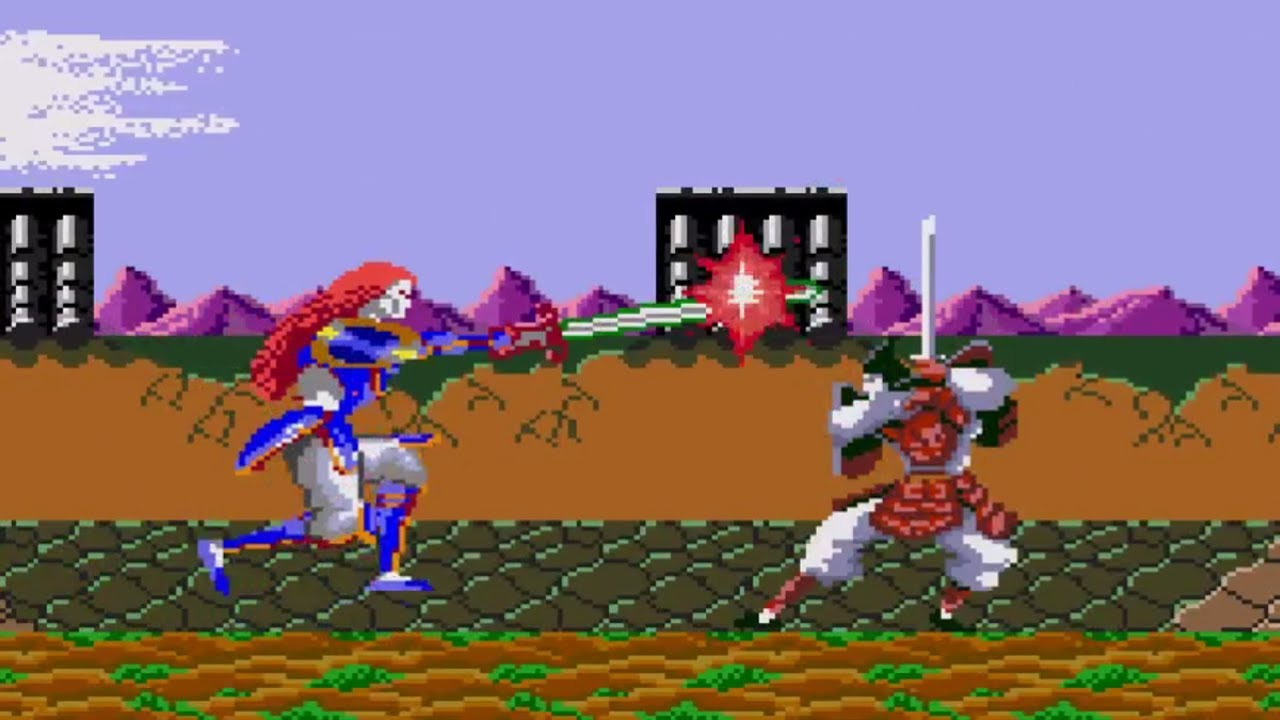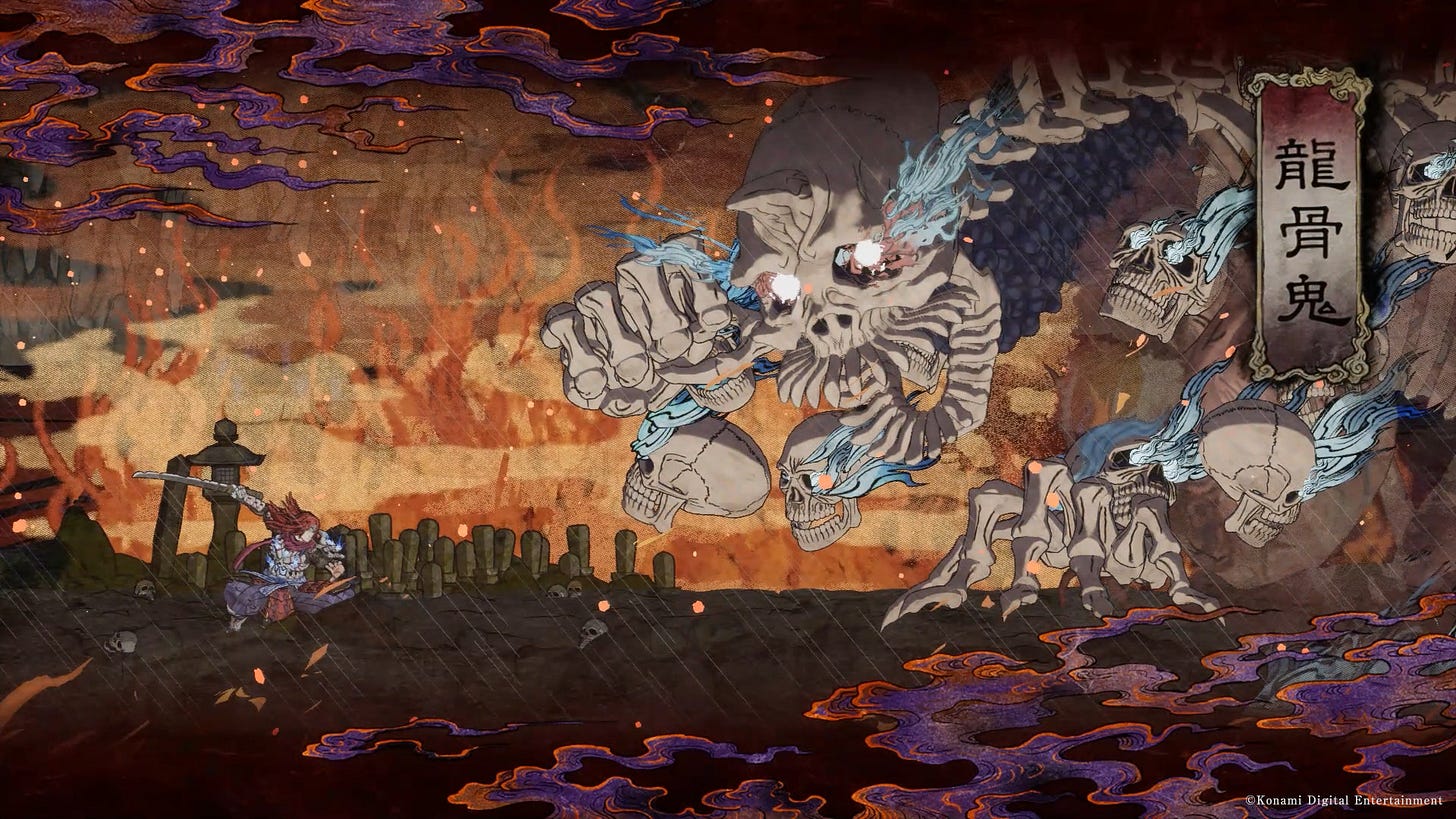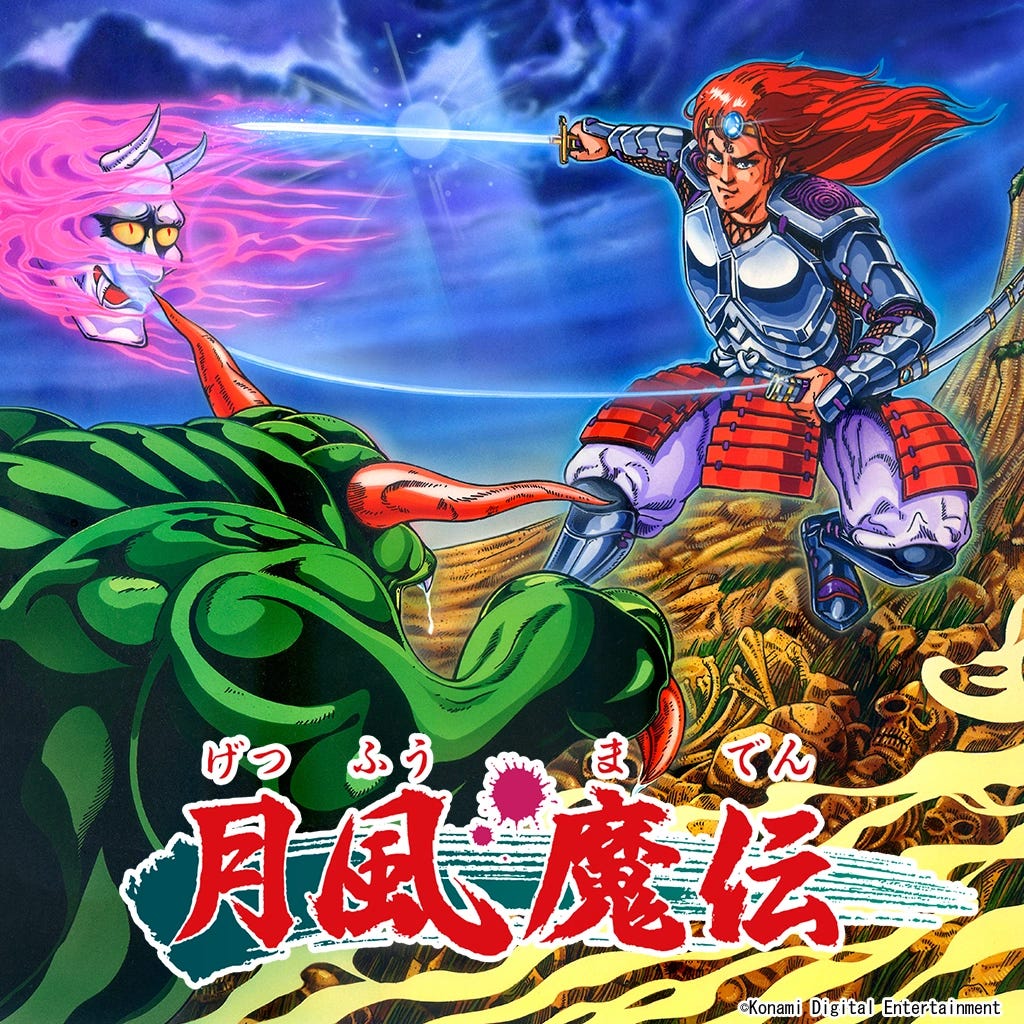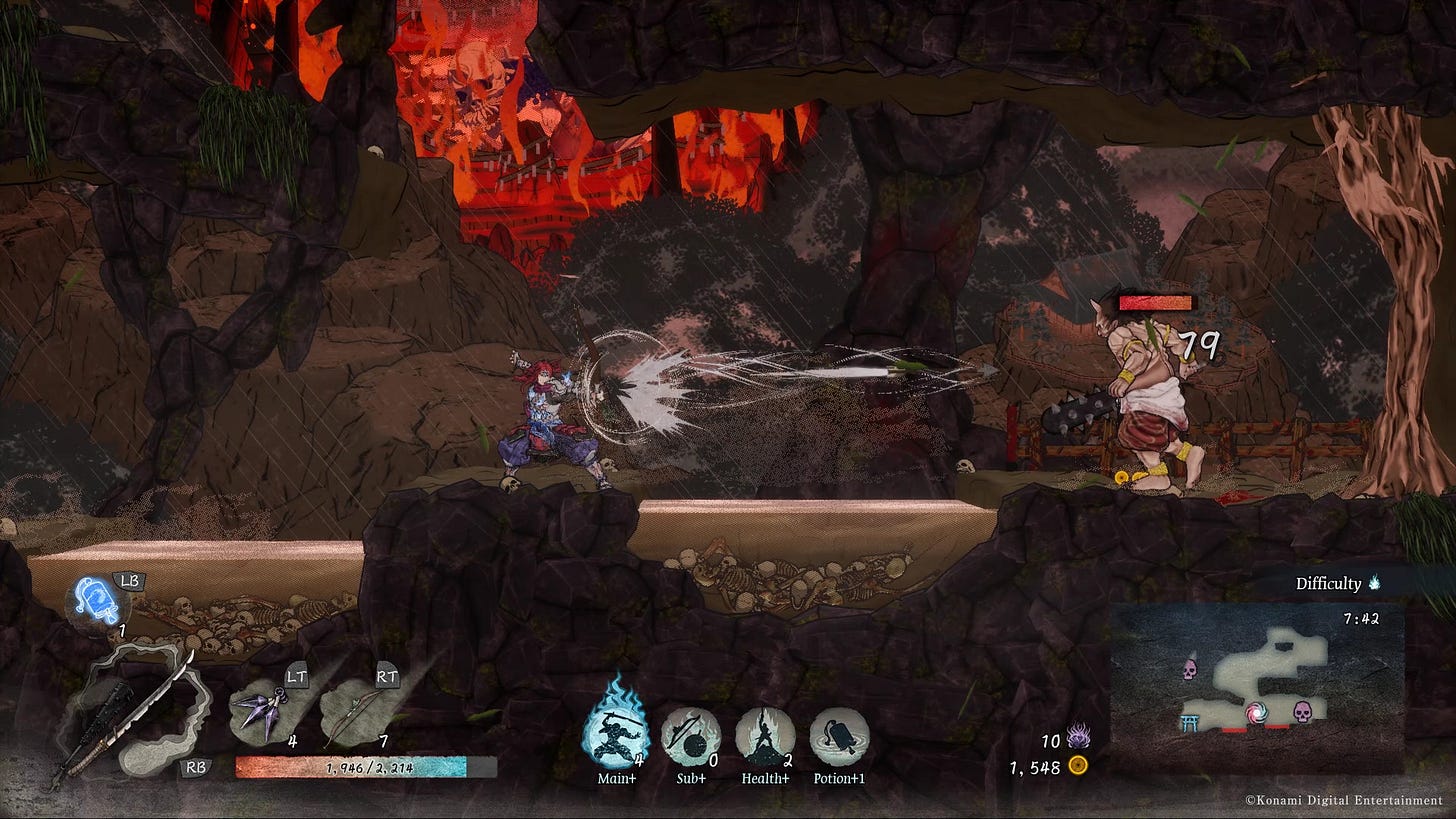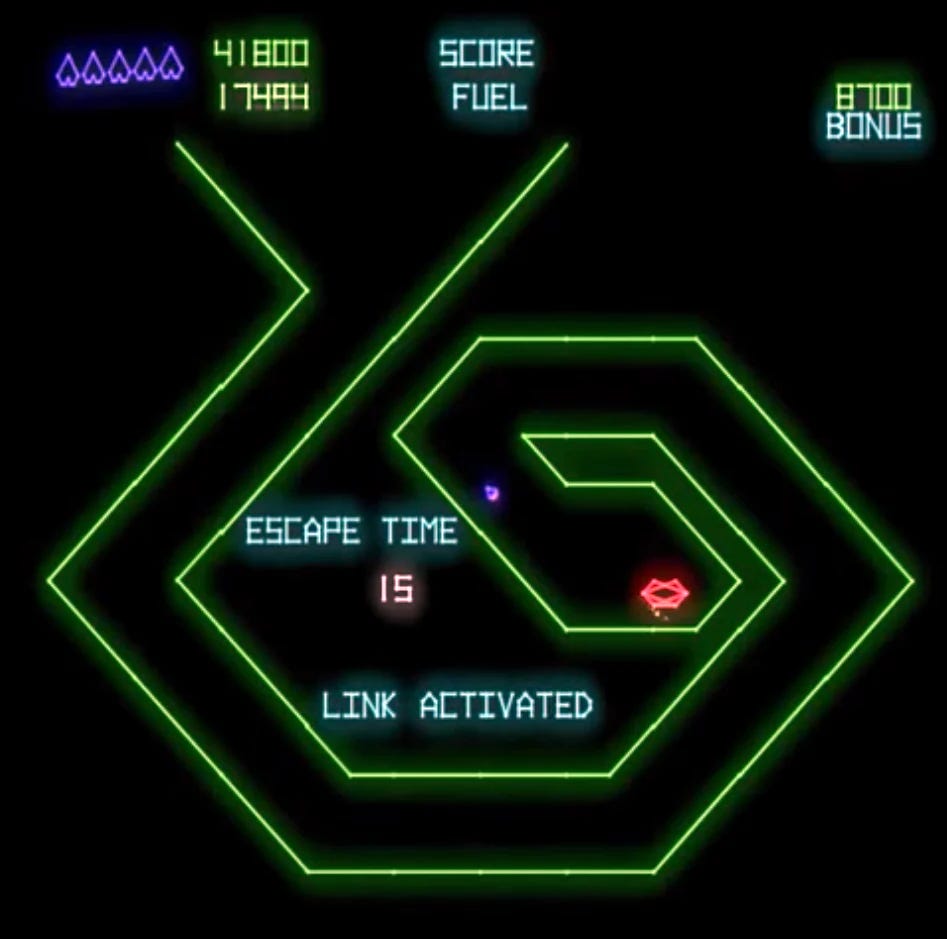“GetsuFumaDen: Undying Moon”: a rip-off twice removed
and “Genpei Toma Den”, the bizarre classic semi-forgotten
When “Getsufumaden: Undying Moon” was announced on Steam, I was so excited that I blind bought it based on a preview. I had been dying to play the original arcade game which I had heard about discussed dismissively on “Retronauts”. The screenshots I had seen bizarrely showed a samurai fighting his way out of hell. Despite looking everywhere, I couldn’t find it on emulation. Now it was being remade, and I could finally play it.
But when I actually played the game, I was underwhelmed. Rather than a remake or something unique, “GetsuFumaDen: Undying Moon” was a copy of the roguelite “Dead Cells”. “Dead Cells” is a snappy action roguelite where one runs around a procedurally generated level killing two or more enemy types to farm upgrade material. If the game had the responsive combat of Dead Cells, it would have been decent, but the action felt slow and plodding and there wasn’t much to the game besides a grind.
Well, at least they had included a port of the original game so that was nice. But the game included was not the Japanese arcade game that I had seen screenshots of, it was rather an untranslated port of a Famicom (the Japanese version of the NES) game that seemed far inferior to the original.
Later, I was eventually able to play a port of the game I had seen screenshots of. It turns out that it had been released onto PC-Engine (TurboGraphix 16 here) in Japan but was never imported to the U.S., perhaps because the style of the game was deemed unappealing to Western audiences. Only the sequel “Samurai Ghost” was released in the West as it was more straightforward. After finally getting to play it, I was baffled as to why Konami had not released this better port instead of the Famicom one, this prompted me to do a bit of research.
I’ve been avoiding saying the title of the original game because of what I discovered in my research. With my limited knowledge of Japanese, I had mistaken “Getsu Fuma Den”, the Konami rip-off produced for Famicom, with “Genpei Toma Den”, the absurdist original made for arcades in Japan by Namco. The game has been translated as “The Genji-Hekke Clans” and is on some arcade collections (Most notably Namco Museum Vol. 4, it’s also available separately through Arcade Classics on PlayStation and Nintendo Switch but not on Steam.)
It's appropriate that “Getsu Fuma Den”, being a rip-off of a property of its day, would in the next generation copy what is now in vogue. “GetsuFamaDen: Undying Moon” is by no means a bad game but it’s definitely not an interesting one. Unlike “Genpei Toma Den”, the modern reboot of “Getsu Fuma Den” doesn’t try anything experimental with its gameplay. The art-style replicates traditional Japanese scroll paintings of hell populated with grotesque yokai in a very arresting way, but the actual gameplay feels very inert.
While “Dead Cells” is snappy and responsive in its combat, “GetsuFumaDen” is slow without having real weight. This especially doesn’t work in a roguelite where speedy runs are the essence of the genre.
What is a shame is that “Genpei Toma Den” remains unknown, yet its copy has been introduced to a new generation of gamers. This would be like if “8 Eyes” had a successful sequel on the PS1 instead of “Symphony of the Night”. No doubt part of the reason is that Bandai-Namco has “Elden Ring” and other popular franchises to concentrate on, whereas Konami has tanked in recent years. Several of the reviews I read seemed surprised that Konami could still make a competent game. Competent though “GetsuFumaDen” is, it’s nothing groundbreaking like the gonzo original.
“Genpei Toma Den” had been a huge influence on Japanese gaming in the 1980’s, inspiring a multitude of copycats. The formula and story have been aped from the original “Getsu Fuma Den” to “Kenseiden” for the Sega Master System. Despite these wide-ranging influences, it has remained largely unknown in the west except as an oddity talked about on a few retro gaming channels.
“Genpei Toma Den is an eccentric and brilliant game, as strange an arcade project as late-period Atari oddities such as “Major Havoc”, “Gravitar” and “I, Robot”. The game starts with a frightening looking hag laughing mockingly at the screen and then becomes a hectic side-scroller where your tiny samurai is being assailed on all sides by various hellish grotesqueries.
There is a primal busyness to what’s going on the screen. A profusion of sprites representing different yokai spawn endlessly and the gameplay can almost feel like survival horror in the difficulty in just making it to the end. This combined with an atonal and all over the place score means that “Genpei Toma Den comes across very strangely.
What makes the game comparable to “Major Havoc” or “Gravitar” is its comfort with shifting between different gameplay modes. When your character reaches a “torii” (a traditional Japanese gate) the perspective shifts and your character now take up ½ of screen, looking slightly marionette like as you use the left stick to control his sword arm. Perhaps because I have “Dark Souls” on the brain, these sections feel a bit soulsy in the sense that precise control of your sword is important. The combat here focuses on large boss enemies, countering and attacking needs to be done somewhat precisely although nowhere near as precisely as a modern game. After beating a boss, the perspective shifts again to an overhead map where one can again reach another “torii” and progress across the map.
Was switching from different gameplay perspectives common at that time? It seems like this is mostly something modern games stay away from. I’m fascinated by the experimentalism on display in “Gravitar” or “Commander Havoc”. Each of these vector graphic masterpieces are 3 different gameplay genres in one. “Genpei Toma Den” may be less bold, but the way oscillates between different kinds of action games is a successful and sustained experiment.
What these different modes represent is a fantasy tale about actual Japanese historical figures (possibly because they are represented in Japanese literature), Taira No Kakego, a redheaded samurai, returns from the grave. Kakego seeks revenge for perishing in the battle of Dan-No-Ura and has to battle his way out of hell. In real life the game’s villain, Miramoto No Yorimoto was the first Shogun of Japan so Kakego’s resurrection historically was much less successful. I find this story so pleasantly weird as if there was a game where you played as a resurrected Abraham Lincoln who has to battle his way out of hell to fight John Wilkes Booth.
The game is recognized in Japan as a legitimate classic, but it seems that the U.S. is where people are hung up on the technical weirdness and difficulty of the gameplay experience. The Wikipedia lists many US game critics used to blander arcade fare chafing at the inclusion of the game on the release of the “PC Engine Mini”.
I think we should celebrate “Genpei Toma Den” as a bizarre work of genius and not only solidly ahead of its time but like “Gravitar”, a game that points to a more exciting way the art form could have developed. All things revolutionary have their rough edges but they merely add flavor to the experience.
(A brief note: this is not a review of the original “GetsuFumaDen” on Famicom which is also an interesting game in it’s own right, albeit one I haven’t played much of. My focus here was to point out that the business decision to remake what was a copy rather than the original was odd. This is not to take anything away from “GetsuFumaDen” only what I found lacking in its remake)




